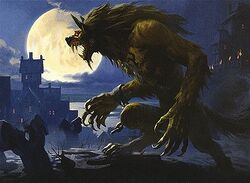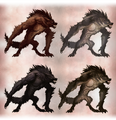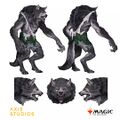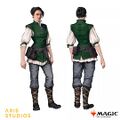Werewolf: Difference between revisions
>Lol pie mNo edit summary |
>RudleyDudley (Visual Guide, Innistrad) |
||
| Line 43: | Line 43: | ||
===Innistrad=== | ===Innistrad=== | ||
Werewolves prowl the [[Innistrad (plane)|Innistrad]] province of [[Kessig]], sometimes alone and sometimes in packs.<ref>{{DailyRef|savor-flavor/planeswalkers-guide-innistrad-kessig-and-werewolves-2011-10-05|A Planeswalker's Guide to Innistrad: Kessig and Werewolves|Magic Creative Team|October 05, 2011}}</ref> ''Hunter's Moon'' is considered to be the time when werewolves are the strongest. Since there are more [[human]]s hunting and traveling in the woods during these months, werewolf attacks are more prevalent. The humans believe the attacks have something to do with the season itself, although there are no more werewolves at this time than any other time of year. | Werewolves prowl the [[Innistrad (plane)|Innistrad]] province of [[Kessig]], sometimes alone and sometimes in packs.<ref>{{DailyRef|savor-flavor/planeswalkers-guide-innistrad-kessig-and-werewolves-2011-10-05|A Planeswalker's Guide to Innistrad: Kessig and Werewolves|Magic Creative Team|October 05, 2011}}</ref> ''Hunter's Moon'' is considered to be the time when werewolves are the strongest. Since there are more [[human]]s hunting and traveling in the woods during these months, werewolf attacks are more prevalent. The humans believe the attacks have something to do with the season itself, although there are no more werewolves at this time than any other time of year. | ||
The curse of lycanthropy is generally not transferred by bite on Innistrad. Instead, those cursed live normal lives until they hear a howl from the forest, summoning them on their first hunt.<ref name="Visual Guide">[[Jay Annelli]] (2022). ''[[Magic: The Gathering - The Visual Guide]]'', [[Wikipedia:DK (publisher)|DK]]. ISBN-13 978-0744061055.</ref> From that day forward, they retain a dual nature between man and werewolf, only able to stave off the change for so long before they must hunt again. | |||
[[Emrakul]]'s corruption tended to affect the two aspects of the werewolves asymmetrically. They might seem normal in human form, but physically and mentally warped in wolf form or vice versa. In the later stages of corruption, the more corrupted side took over and the werewolves lost their ability to transform at all.<ref name="Art of Innistrad"/> | [[Emrakul]]'s corruption tended to affect the two aspects of the werewolves asymmetrically. They might seem normal in human form, but physically and mentally warped in wolf form or vice versa. In the later stages of corruption, the more corrupted side took over and the werewolves lost their ability to transform at all.<ref name="Art of Innistrad"/> | ||
Revision as of 09:47, 18 January 2024
| Werewolf | |
|---|---|
| Creature Type | |
| (Subtype for creature/kindred cards) | |
| Beeble Scale | 3 (6 out of Innistrad)[1] |
| Statistics |
150 cards
as of Alchemy: Innistrad |
| Scryfall Search | |
| type:"Werewolf" | |
Werewolf is a creature type, which represents instinctive, seemingly human creatures which can transform into bloodthirsty wolf-like beasts. Werewolves are often attributed with superhuman strength and senses, far beyond those of both wolves and humans, or most sapient bipeds.
Card history
The first two printed werewolves had the creature type Lycanthrope. Lycanthrope (from the Greek λυκάνθρωπος: λύκος, lukos, "wolf", and άνθρωπος, anthrōpos, man) was obsoleted in the Grand Creature Type Update, when the Lesser Werewolf (Legends) and the Greater Werewolf (Homelands) became Human Wolves. Treacherous Werewolf (Judgment) never even had the subtype Lycanthrope.[2]
A special Werewolf subtype was (re)introduced for the classical Horror set Innistrad, and the three old cards were updated with that subtype. While these earlier werewolves were all black, the new double-faced Werewolf cards from Innistrad were red or green.[3][4][5]
In Innistrad: Midnight Hunt, black returned as a werewolf color, appearing on three werewolf cards in the set. Additionally, the remaining colors each got a "cameo", with a white or blue human werewolf on the daybound face, and respectively a red or green non-human form on the nightbound face.[2]
Werewolf mechanics
Transform, and the Innistrad theme of double-faced cards with day and night sides, were designed after the werewolf legend; humans who turn into monsters when a full moon is present at night.[6]
The original "Werewolf mechanic" (the trigger that transformed the cards) was as follows:[2]
- "At the beginning of each upkeep, if no spells were cast last turn, transform ~" (Humans into Werewolves)
- "At the beginning of each upkeep, if a player cast two or more spells last turn, transform ~" (Werewolves into Humans)
In Eldritch Moon, seven (non-human) werewolf horrors instead transformed with an activated ability, costing a significant amount of mana. This one-way transformation turned them into colorless Eldrazi werewolves.
Dungeons & Dragons: Adventures in the Forgotten Realms featured one single-faced human werewolf card. Despite not being a transforming card, it featured an activated ability to modify its characteristics similar to transforming until the end of the turn.

Innistrad: Midnight Hunt returned to the original design of the werewolf mechanic and the idea of day/night with a twist. This resulted in:
- Daybound (If a player cast no spells during their turn, it becomes night next turn.)
- Nightbound (If a player cast at least two spells during their turn, it becomes day next turn.)
Although similar in wording to the original mechanic, there are some differences. It only tracks the player whose turn it is so you can't interfere with the opponent transforming. However, the shift from day to night changes everyone's cards. Cards can also enter on the nightbound side.
Storyline
Ulgrotha
Ulgrotha was home to powerful beasts inhabiting the land of the Dark Barony. When someone survived a bite from one of these creatures, the victim would become a werewolf loyal to the one who bit him or her. The corrupt wizard savant who gave Eron the Relentless his immortality was made into the first greater werewolf as punishment by Baron Sengir and became the baron's loyal servant.
Dominaria
Greater werewolves are also present on Dominaria and can be found in the region of Upper Videnth. During the Ice Age, many such lycanthropes traversed the expanding ice shelves from the northern supercontinent to Terisiare.
Innistrad
Werewolves prowl the Innistrad province of Kessig, sometimes alone and sometimes in packs.[7] Hunter's Moon is considered to be the time when werewolves are the strongest. Since there are more humans hunting and traveling in the woods during these months, werewolf attacks are more prevalent. The humans believe the attacks have something to do with the season itself, although there are no more werewolves at this time than any other time of year.
The curse of lycanthropy is generally not transferred by bite on Innistrad. Instead, those cursed live normal lives until they hear a howl from the forest, summoning them on their first hunt.[8] From that day forward, they retain a dual nature between man and werewolf, only able to stave off the change for so long before they must hunt again.
Emrakul's corruption tended to affect the two aspects of the werewolves asymmetrically. They might seem normal in human form, but physically and mentally warped in wolf form or vice versa. In the later stages of corruption, the more corrupted side took over and the werewolves lost their ability to transform at all.[9]
The Krallenhorde
The Krallenhorde is Innistrad's largest howlpack. The Krallenhorde has existed in some form for decades, composed of anywhere from fifty to over two hundred werewolves depending on the availability of prey and the phase of the moon. The pack is led by Ulrich, and he is known for staying with the wolves even in human form. The most heterogeneous of howlpacks, Krallenhorde includes a mix of repentant and wanton werewolves and has drawn members from all provinces of Innistrad. The Krallenhorde survived the Cursemute intact.[9]
The Mondronen howlpack
This howlpack, about 60 in size, was known for using a dark form of magic. They stayed away from civilization and stayed in farmlands, rural communities, and remote monasteries. With Avacyn's protective wards getting weaker, the Mondronen got closer to cities. After the return of Avacyn, the howlpack was dissolved.[9]
The Leeraug howlpack
A relatively small and tight-knit pack of Innistrad's most vicious werewolf predators. The Leeraug were unique in that they hunted under the black night of the new moon, rather than transforming when the moon was full. They favored the flesh and entrails of children, and often stole into homes and orphanages through chimneys or windows left ajar. After the return of Avacyn, the howlpack was dissolved.[9]
The Vildin Howlpack
An especially infamous group of werewolves appeared after the end of the Cursemute. It is said that this howlpack calls into its ranks only those humans who have murdered before becoming a werewolf.[9] They dwell in the Natterknolls of Kessig and the Stensian Highlands.
Wolfir
Avacyn offered repentant humans afflicted by the lycanthropic curse a special place at her side. If they promised to serve as guardians of humanity, she would transform their curse, fusing the two warring aspects into a single noble creature. Many accepted her offer, and she transformed them into the wolfir. The transformation was mostly reversed when Avacyn was corrupted through the machinations of Nahiri.[10] It is said that only a few remain;[11] at least two or three were in the The Gatewatch's resistance group after the falling of the Eternal Night.[12]
The Silverfurs
A ragged handful of the remaining Wolfir have formed a kind of virtuous howlpack. They are led by Johanna and Pavel.[9]
The Dronepack
After the death of Avacyn, the Somberwald became a hunting ground for the Dronepack, a group of werewolves that had succumbed to the flesh-warping powers of Emrakul.
The Dire pack
The strong sway of the errant moon produced a new breed of werewolf called the dire strain. In human form, these werewolves are markedly tall, lanky folk with a grim cast to their appearance. They distrust others, looking strangers up and down with their sunken, beady eyes, somehow both suspicious and bored. They are most comfortable in their wolf skin. In werewolf form, they grow far larger than other werewolves, with legendary strength and speed. They're capable of shredding stone with their claws and snapping bone with the slightest bite, and they're said to shrug off even blessed silver. The dire-strain werewolves are Tovolar's heavy hitters, the true powerhouses of his army.[13][14]
Notable Werewolves
- Innistrad
- Arlinn Kord — a werewolf planeswalker
- Howlpack Alpha — a werewolf lord
- Immerwolf
- Ironfang
- Rahilda — Alpha of the Vildin howlpack
- Skaharra — Alpha of the Leeraug howlpack
- Terror of Kruin Pass
- Tovolar — Alpha of the Mondronen howlpack
- Ulrich — Alpha of the Krallenhorde howlpack
Gallery
-
Arlinn, Embraced by the Moon
-
Werewolf concepts.
-
Werewolf concepts.
-
Werewolf concepts.
-
Midnight Hunt Werewolf promo art by Alben Tan.
-
Werewolf concept.
-
Human Werewolf concept.
-
Human Werewolf face studies.
-
Werewolf 3D model.
-
Human Werewolf 3D model.
-
Tim Werewolf 3D model.
-
Werewolf mask worn by Jerren.
-
Werewolf incense burner depicting the transformation.
-
Werewolf storyboard.
-
Werewolf storyboard.
Trivia
- The instant Moonmist transforms all Humans. While this only affects double-faced cards, it has some strange results with other transforming cards.
- On April 6, 2012 (which featured a full moon) a double-sided token was released as a special FNM card. It fittingly represented a 1/1 human on one side, and a 2/2 wolf on the other.[15]
- Kessig Wolf Run portrays the homeland of Wolves and Werewolves alike.
- Full Moon's Rise is an enchantment that grants bonuses to werewolf creatures.
- Sometimes other humans can shapeshift into creatures other than wolves. Odyssey has a were-creature theme with Dirty Wererat and Werebear, which were both native to Otaria. These are Human Rat and Human Bear respectively.
- Threshold creatures in Odyssey are all lycanthropes, meaning they change from one thing into another. The creature type line captures the before and after, but the art only shows one, usually after.[16]
- Mild-Mannered Librarian, through a mana payment, becomes a werewolf. It is suggested that the magic to do so is less druidic or biological in source, but through literary magic.
References
- ↑ Mark Rosewater (October 22, 2018). "Werewolves on the Beeble Scale?". Blogatog. Tumblr.
- ↑ a b c Mark Rosewater (September 2, 2021). "Happy Hunt-ing, Part 1". magicthegathering.com. Wizards of the Coast.
- ↑ Mark Rosewater (September 05, 2011). "C'mon Innistrad, Part 1". magicthegathering.com. Wizards of the Coast.
- ↑ Mark Rosewater (October 3, 2011). "Were the Wild Things Are". magicthegathering.com. Wizards of the Coast.
- ↑ Mark Rosewater (January 09, 2012). "Dancing in the Dark Ascension, Part 1". magicthegathering.com. Wizards of the Coast.
- ↑ Tom LaPille (September 16, 2011). "Werewolves Gone Wild". magicthegathering.com. Wizards of the Coast.
- ↑ Magic Creative Team (October 05, 2011). "A Planeswalker's Guide to Innistrad: Kessig and Werewolves". magicthegathering.com. Wizards of the Coast.
- ↑ Jay Annelli (2022). Magic: The Gathering - The Visual Guide, DK. ISBN-13 978-0744061055.
- ↑ a b c d e f James Wyatt 2016, "The Art of Magic: The Gathering - Innistrad".
- ↑ Ken Troop (March 9, 2016). "A Gaze Blank and Pitiless". magicthegathering.com. Wizards of the Coast.
- ↑ K. Arsenault Rivera (September 2, 2021). "Episode 1: The Witch in the Woods". magicthegathering.com. Wizards of the Coast.
- ↑ K. Arsenault Rivera (October 28, 2021). "Tithes and Invitations". magicthegathering.com. Wizards of the Coast.
- ↑ Prepare for the Harvesttide Festival – Innistrad: Midnight Hunt (Video). Magic: The Gathering. YouTube (September 2, 2021).
- ↑ Doug Beyer and Ari Zirulnik (September 9, 2021). "Planeswalker's Guide to Innistrad: Midnight Hunt". magicthegathering.com. Wizards of the Coast.
- ↑ Monty Ashley (March 28, 2012). "The Double-Faced Token". magicthegathering.com. Wizards of the Coast.
- ↑ Mark Rosewater (February 8, 2020). "Krosan Beast's typeline explicitly calls it a Squirrel (Creature - Squirrel Beast).". Blogatog. Tumblr.













